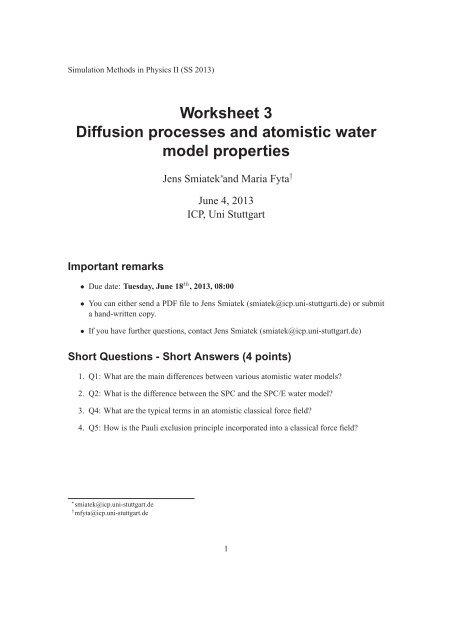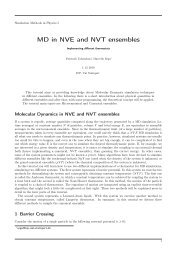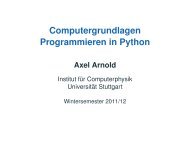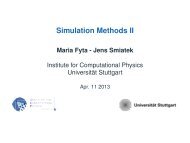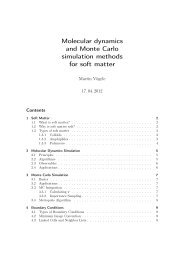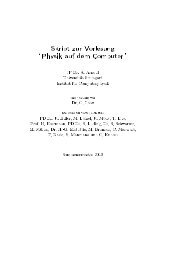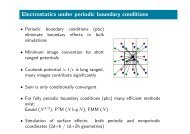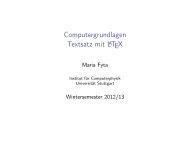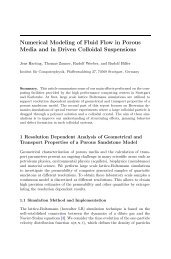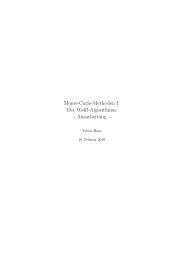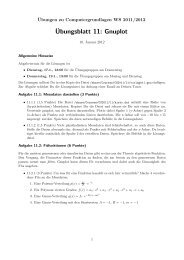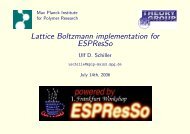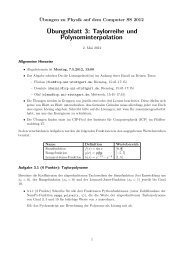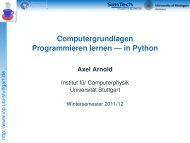Worksheet 3 (the work sheet as a single PDF file) - Institute for ...
Worksheet 3 (the work sheet as a single PDF file) - Institute for ...
Worksheet 3 (the work sheet as a single PDF file) - Institute for ...
Create successful ePaper yourself
Turn your PDF publications into a flip-book with our unique Google optimized e-Paper software.
Simulation Methods in Physics II (SS 2013)<br />
<strong>Work<strong>sheet</strong></strong> 3<br />
Diffusion processes and atomistic water<br />
model properties<br />
Jens Smiatek ∗ and Maria Fyta †<br />
June 4, 2013<br />
ICP, Uni Stuttgart<br />
Important remarks<br />
• Due date: Tuesday, June 18 th , 2013, 08:00<br />
• You can ei<strong>the</strong>r send a <strong>PDF</strong> <strong>file</strong> to Jens Smiatek (smiatek@icp.uni-stuttgarti.de) or submit<br />
a hand-written copy.<br />
• If you have fur<strong>the</strong>r questions, contact Jens Smiatek (smiatek@icp.uni-stuttgart.de)<br />
Short Questions - Short Answers (4 points)<br />
1. Q1: What are <strong>the</strong> main differences between various atomistic water models?<br />
2. Q2: What is <strong>the</strong> difference between <strong>the</strong> SPC and <strong>the</strong> SPC/E water model?<br />
3. Q4: What are <strong>the</strong> typical terms in an atomistic cl<strong>as</strong>sical <strong>for</strong>ce field?<br />
4. Q5: How is <strong>the</strong> Pauli exclusion principle incorporated into a cl<strong>as</strong>sical <strong>for</strong>ce field?<br />
∗ smiatek@icp.uni-stuttgart.de<br />
† mfyta@icp.uni-stuttgart.de<br />
1
Theoretical T<strong>as</strong>k: Langevin equation - Calculation of particle<br />
positions and velocities<br />
The Langevin equation is an effective description <strong>for</strong> particle diffusion in an implicit solvent.<br />
The <strong>for</strong>ce on a particle is given by a dissipative and a stoch<strong>as</strong>tic <strong>for</strong>ce. The corresponding<br />
differential equation in one dimension is given by<br />
d˙v = −γvdt+ Γ dW (1)<br />
m<br />
where <strong>the</strong> first term on <strong>the</strong> r.h.s. describes <strong>the</strong> dissipative <strong>for</strong>ce where<strong>as</strong> <strong>the</strong> second term incorporates<br />
<strong>the</strong> stoch<strong>as</strong>tic <strong>for</strong>ce in terms of Gaussian white noise. It h<strong>as</strong> to be noted that <strong>the</strong><br />
corresponding moments of <strong>the</strong> random <strong>for</strong>ce in terms of a Wiener process are given by<br />
and<br />
< dW(t) >= 0 (2)<br />
< dW(t)dW(t ′ ) >= dt ′ . (3)<br />
The velocities of <strong>the</strong> particles are connected via <strong>the</strong> equipartition <strong>the</strong>orem<br />
with <strong>the</strong> <strong>the</strong>rmal energy k B T .<br />
1<br />
2 mv2 = 3 2 k BT (4)<br />
T1: Velocities of <strong>the</strong> particle (3 points)<br />
Ple<strong>as</strong>e calculate <strong>the</strong> velocity <strong>for</strong> a particle in one dimension by solving Eqn. 1 and taking <strong>the</strong><br />
properties of <strong>the</strong> Wiener process into account. Ple<strong>as</strong>e give an expression <strong>for</strong> <strong>the</strong> prefactor Γ in<br />
Eqn. 1 by applying <strong>the</strong> equipartition <strong>the</strong>orem. In addition, look at <strong>the</strong> limit of long time scales.<br />
T2: Position of <strong>the</strong> particle (3 points)<br />
Ple<strong>as</strong>e calculate <strong>the</strong> position of <strong>the</strong> particle in <strong>the</strong> limit of long time scales. Give an expression<br />
<strong>for</strong> <strong>the</strong> diffusion constant by regarding <strong>the</strong> expression <strong>for</strong> <strong>the</strong> mean-square displacement.<br />
Computational T<strong>as</strong>k: Atomistic water simulations with<br />
GROMACS (10 points)<br />
In this exercise we will simulate <strong>the</strong> properties <strong>for</strong> different water models with GROMACS<br />
which is a freely available Molecular Dynamics software package (www.gromacs.org). We<br />
will focus on <strong>the</strong> SPC, SPC/E and TIP3P water models. In this t<strong>as</strong>k, GROMACS will serve<br />
<strong>as</strong> a simulation engine. In <strong>the</strong> next <strong>work</strong><strong>sheet</strong> we will learn how to set up a simulation with<br />
GROMACS.<br />
2
C1: Running <strong>the</strong> simulation (4 points)<br />
Ple<strong>as</strong>e download <strong>the</strong> corresponding zip-archive from <strong>the</strong> webpage. After unpacking, you will<br />
find different <strong>file</strong>s in <strong>the</strong> directory.<br />
The <strong>file</strong>s are:<br />
• spc216.gro: pre-equilibrated water structure with 216 solvent molecules<br />
• grompp.mdp: Parameters <strong>for</strong> <strong>the</strong> simulation<br />
• topol.top: Topology <strong>file</strong> <strong>for</strong> <strong>the</strong> water simulation which includes a link to <strong>the</strong> <strong>for</strong>ce field<br />
parameters<br />
• index.ndx: File which is needed <strong>for</strong> <strong>the</strong> analysis<br />
Open <strong>the</strong> water configuration (spc216.gro) with vmd.<br />
vmd spc216.gro<br />
The <strong>file</strong> shows a pre-equilibrated water structure with 216 solvent molecules. Have also a look at<br />
<strong>the</strong> o<strong>the</strong>r <strong>file</strong>s in <strong>the</strong> zip-archive. Copy <strong>the</strong> <strong>file</strong>s into three different directories with <strong>the</strong> names spc,<br />
spce and tip3p. First we will start <strong>the</strong> simulation of <strong>the</strong> SPC water. You can ei<strong>the</strong>r download your<br />
own copy of GROMACS or use <strong>the</strong> CIP computers. In <strong>the</strong> following, <strong>the</strong> usage of GROMACS<br />
with <strong>the</strong> CIP computers will be described.<br />
Type <strong>the</strong> command<br />
/usr/local64/gromacs4.0.4-gcc4.3-static/bin/grompp -v<br />
The command grompp prepares <strong>the</strong> input <strong>file</strong>s <strong>for</strong> <strong>the</strong> simulation. After this, <strong>the</strong> simulation can<br />
be conducted via<br />
/usr/local64/gromacs4.0.4-gcc4.3-static/bin/mdrun -v<br />
The system is simulated <strong>for</strong> 500 ps with a time step of 2 fs at 300 K.<br />
After <strong>the</strong> simulation is finished, change into <strong>the</strong> spce or tip3p directory. Change <strong>the</strong> line<br />
#include "spc.itp"<br />
into<br />
#include "spce.itp"<br />
or<br />
#include "tip3p.itp".<br />
in <strong>the</strong> corresponding topol.top - <strong>file</strong>. Use <strong>the</strong> commands grompp and mdrun to per<strong>for</strong>m <strong>the</strong><br />
simulations <strong>for</strong> all three water models.<br />
3
C2: Analysis of <strong>the</strong> simulation - Radial distribution function (2 points)<br />
GROMACS also offers a broad variety of analysis tools. The radial distribution function between<br />
water molecules gives a first hint towards <strong>the</strong> local water structure. To investigate <strong>the</strong> radial<br />
distribution function, use <strong>the</strong> command<br />
/usr/local64/gromacs4.0.4-gcc4.3-static/bin/g_rdf -n index<br />
and have a look at <strong>the</strong> output <strong>file</strong> with xmgrace or gnuplot. Compare <strong>the</strong> radial distribution<br />
function <strong>for</strong> all three water models and interpret <strong>the</strong> results (peaks, distance between peaks,<br />
differences between <strong>the</strong> water models ...).<br />
C3: Analysis of <strong>the</strong> simulation - Hydrogen bond analysis (2 points)<br />
A crucial feature of water is <strong>the</strong> pronounced effect of hydrogen bonds between <strong>the</strong> oxygen and<br />
hydrogen atoms. The occurrence of <strong>the</strong>se bonds is mainly reliable <strong>for</strong> many important properties<br />
of water. We can determine <strong>the</strong> number of hydrogen bonds within <strong>the</strong> simulated system via<br />
/usr/local64/gromacs4.0.4-gcc4.3-static/bin/g_hbond -n index<br />
where <strong>the</strong> results can be compared between <strong>the</strong> different water models. Ple<strong>as</strong>e calculate <strong>the</strong><br />
average number of hydrogen bonds <strong>for</strong> a water molecule. What is <strong>the</strong> meaning of donors and<br />
acceptors?<br />
C3: Analysis of <strong>the</strong> simulation - Mean-square displacement (2 points)<br />
The diffusion coefficient D can be calculated via <strong>the</strong> mean-square displacement function<br />
< ∆r(t) 2 >= 6Dt (5)<br />
after a timet. You can calculate <strong>the</strong> mean-square displacement in GROMACS via<br />
/usr/local64/gromacs4.0.4-gcc4.3-static/bin/g_msd -n index<br />
Have a look at <strong>the</strong> output <strong>file</strong>s <strong>for</strong> <strong>the</strong> different water models and compare <strong>the</strong>m. What are<br />
<strong>the</strong> differences? Can you identify <strong>the</strong> linear < ∆r(t) 2 >∼ t) and <strong>the</strong> ballistic regime (c.f.<br />
Theoretical t<strong>as</strong>k 1)?<br />
4


